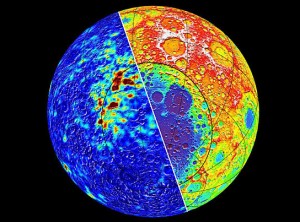Scientists study magnetic anomalies on the moon
Saturday, March 17th, 2012 2:23:22 by Taimoor Tariq
A new reports suggests that the magnetic anomalies observed on the moon are actually remnants of massive asteroid collision which occurred almost 4 billion years ago. According to the research team, the metallic iron on an asteroid could have
been magnetized by the impact and topographical surveys indicate that they are spread around the rim of a huge crater
In the nearly five decades since the first lunar surveys were conducted as part of NASA’s Apollo space program, scientists have advanced a number of increasingly complex theories to explain the vast swaths of highly magnetic material that were found in some
parts of the moon’s crust.
A team of researchers from Harvard, Instituit dee Physique du Globe de Paris and Massachusetts Institute of Technology have given a simple explanation of these findings. According to the researchers, the magnetic anomalies are actually the remnants of an
asteroid collision.
In a paper published on March 9 in Science, researchers have deduced that moon was hit by an asteroid about 4 billion years ago. The collision left behind a gigantic crater and a highly magnetic rock that was rich in iron.
Evidence show that moon has its own magnetic field. To explain the findings, researchers turned to a number of elaborate scenarios.
“The conundrum has always been that the magnetism we see on the moon is not correlated with any surface geology,” she said. “The theory that has been most commonly cited to explain it is an ‘impact-induced field,’ in which an impact concentrates and amplifies
the moon’s magnetic field. But it was difficult to test. People have tried to model it, but it is right at the edge of what could work.
“We have a simpler idea,” she continued. “Because the fields in this area are stronger than those found in any normal lunar rocks, our hypothesis is that it isn’t lunar material. We know the magnetic properties of asteroidal material are much higher than
that of the moon. It is possible that metallic iron from an asteroid could have been magnetized by the impact, and deposited on the moon.”
Their first clue came from the surveys that had long confounded scientists. When combined with more recent, hyper-accurate topographical surveys of the moon’s surface, it quickly became clear that most of the magnetic anomalies are scattered around the rim
of an enormous, 2,400 kilometre-diameter crater known as South Pole-Aitken.
Tags: Amin Fahim, Harvard University, magnetic fields, magnetism, President Ahmadinejad
Short URL: https://www.newspakistan.pk/?p=16141

















